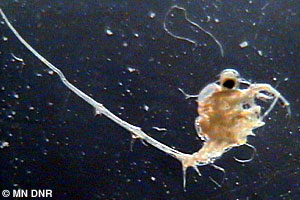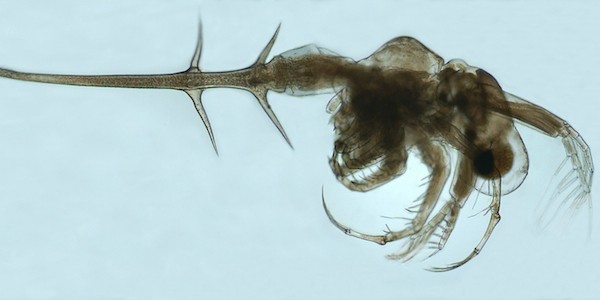By Morgan Linn

The spiny waterflea, adult-sized and magnified. Photo: Minnesota Department of Natural Resources.
The spiny water flea is a small invader causing big problems in Wisconsin.
The invasive crustacean has clouded that state’s
Lake Mendota, which could cost millions of dollars to restore, according to a new study published in the Proceedings of the National Academy of Sciences of the United States of America. The research has implications for other lakes in the region as well.
The spiny water flea was introduced into the region in the 1980s and has proliferated through all five of the Great Lakes, according to the study.
The invader came from the Caspian Sea in Asia and spread throughout Europe, said Steve Carpenter, co-author of the study and director of the Center for Limnology at the University of Wisconsin-Madison.

Lake Mendota. Image: Richard Hurd on flickr
It was accidentally transported across the Atlantic and up the St. Lawrence River by freighters, he said. Ballast taken in to stabilize the vessels in Europe was released in the Great Lakes. That ballast happened to contain spiny water flea.
Lake Mendota, near Madison, now suffers the consequences. The spiny water flea
was discovered there in 2009, Carpenter said. It was most likely transported from Lake Michigan by people fishing.
The “spinys” are a problem because they are big enough to eat other zooplankton, such as daphnia, Carpenter said. And daphnia are critical for maintaining water clarity.
Daphnia eat “so much algae that the lake becomes clear,” said Jake Walsh, the main
author of the study and a graduate student at the University of Wisconsin-Madison. “The spiny water flea eats all the daphnia and water clarity gets worse because there is nothing there to keep algae growth in check.”

Daphnia. Image: Wikipedia
Daphnia in Lake Mendota have been reduced by 60 percent, leading to almost 3 feet of lost water clarity, says the study.
That loss is felt hard by nearby residents.
“People love Lake Mendota, they love doing things on Lake Mendota, and having clearer water makes that better,” Walsh said.
The root of the problem is the increasing amount of phosphorus that fertilizes the algae, Carpenter said.
“One way to get rid of algae is to not fertilize them, and another way is to eat them,” he said. “Spiny water flea takes away the option of eating them, but there’s still the option of turning off the fertilizer.”
But that’s also a challenge.
One way to reduce phosphorus is by treating cow manure now running off of nearby farms, Carpenter said. “What [farmers] are trying to do essentially is to provide sewage treatment for cows.”
Farmers could also reduce or eliminate the use of commercial phosphorus fertilizer, which also runs off of fields and into lakes.
There are many obstacles to preventing runoff.
Reversing the damage caused by the spiny water fleas would cost $86.5 million to $163 million, according to the study.
And it’s unsure who should pay that bill, Walsh said. What would work best is a partnership between citizens and farmers.
And it’s not just costs of new methods.
“Compliance is not great,” Carpenter said. “Not every farmer agrees or is willing to help out to reduce the pollution problem, so there’s a lot of variability among farmers and really you need all of them to carry the ball.”
Things are also complicated because phosphorus remains in the soil for a long period of time. That means it takes a long time to clean it up.
And there is a lot to clean up. To reverse the damage done by the spinys, the phosphorus would have to be reduced by 71 percent.
“There are many success stories for diverting human sewage, but there are very few, maybe zero, success stories for managing farm runoff,” Carpenter said.
But there is hope for Lake Mendota. The area values the water clarity that was lost at $140 million, according to a survey done in 2001.
Because the value of the clarity and the cost to restore it are similar, it could be worth the effort and money to restore Lake Mendota, Walsh said.
The community has already invested in cleaning the lake, Carpenter said. “I think the message to the local community is now is the time to redouble that effort.”
But another point: the water fleas might not be there to stay. Since they prefer cooler waters and invaded Lake Mendota when temperatures were exceptionally low, rising water temperatures may prove harmful, Carpenter said. It might take 20 years, but global warming could threaten them and eventually kill them off.
Spinys not only threaten water clarity, their spines get caught in fishing lines, wrecking fishing gear, according to the United States Geological Survey.
To keep them from spreading, boaters should thoroughly wash and dry boats before moving to another lake, Walsh said.
Knowing how much invasions could cost is essential to weighing benefits of large-scale prevention initiatives, the study said.

Location of spiny water flea in the United States. Dark brown indicates presence of fleas. Image: United States Geological Survey
Previous estimates of how much invasions cost did not include smaller but valuable inland lakes like Lake Mendota. That means the costs of invasions are much higher than anticipated, the researchers said.
Related article about preventative measures and the impact of spiny water flea here.
